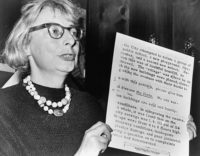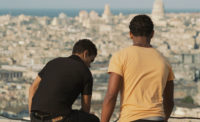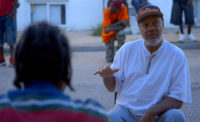
For nearly 75 years, Batman and Gotham City have been symbiotically connected, one essential to the formation of the other. And each new iteration of the character has brought with it a new city. Gotham began life as an exaggerated New York, but since the 1980s, Batman has become darker and more psychological, and with him, the city has become more conceptual and nightmarish. Director Christopher Nolan's Dark Knight Trilogy, which concludes with The Dark Knight Rises, rescues Gotham from the couch by presenting it, instead, as a real city with real horrors. In Nolan's films, Gotham City represents America in the age of terrorism.
Previous Batman movies conceived Gotham as a world outside time and reality. The city in Tim Burton’s Batman (1989) and Batman Returns (1992), for example, was created on soundstages and backlots and seems to have sprung out of the subconscious, with Art Deco and Expressionist accents grafted onto a noir cityscape. It's visually exciting, for sure, but more dreamlike than urban reality.
Nolan's films go in the opposite direction. His Gotham City is tangible, based in existing physical spaces, yet anonymous enough to be anywhere. This reflects his desire, articulated in the book The Art and Making of The Dark Knight Rises (2012), to make an action/adventure film rooted in verisimilitude rather than a fantastical comic book movie. But it’s also a result of an urban hodgepodge created by three different reality-based interpretations of Gotham over the course of the trilogy.
The Gotham of Batman Begins (2005) is a Chicago-New York-soundstage mash-up, Second City's infrastructure built on top of Fun City's landscape. Next in the series, the Gotham of The Dark Knight (2008) is Chicago through and through, a unified moden urbanscape shot on location. The Dark Knight Rises (2012) renders Gotham with a pastiche of New York, Pittsburgh, and Los Angeles. Characters and action move, in the space of a cut, between identifiable landmarks from all three cities.
By splicing together cities ranging in size from megalopolis to midsized, from East to West Coast, Nolan creates a based-in-reality Gotham that could be Anycity, USA. He then infuses it with the looming threat of terrorism, which breeds a familiar culture of fear. This allows heroes (Batman, Harvey Dent, the police) to engage in headline-derived forms of rendition, torture, and conspiracy in the name of civic safety. It drives villains (Scarecrow, Joker, Bane) to unleash chemical, anarchic, and nuclear attacks against Gotham and its citizens in the name of twisted ideology. And the people of the city are reduced to helplessness and terror, caught between incomprehensible forces. This is 21st-century America in microcosm. With recognizable-yet-unspecific cityscapes, the trilogy implies that any city can be a target and every population is susceptible to the self-destruction of suspended rights and dread, a familiar specter in post-September 11 America.
Indeed, September 11 looms over each of Nolan’s Gothams. The first two movies feature numerous visual callbacks to the immediate aftermath of the attacks and the rescue work at Ground Zero (people grope and stagger through a thick haze after a chemical agent is dispersed in Batman Begins, Batman stands atop the rubble of a bombed warehouse while fire fighters search for survivors in The Dark Knight). But the connection is made explicit in The Dark Knight Rises. The simultaneous destruction of Gotham landmarks that are clearly real-life icons—New York's Brooklyn, Williamsburg, and Queensboro Bridges; Pittsburgh's Heinz Field; LA streetscapes—deliberately evokes the coordination of the September 11 attacks.
The Gotham of Nolan’s trilogy is the one his hyper-realistic Batman deserves—and it’s the one our times demand. With it, Nolan subverts the summer escapism of the superhero film and delivers a defining statement about cities—and America—in the 21st century. There’s a deep reservoir of fear and chaos just below the surface of urban normalcy. All it takes is a nudge from an anarchic clown or a terrorist for it to flood the surface.



